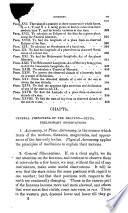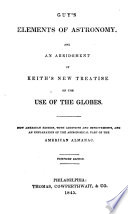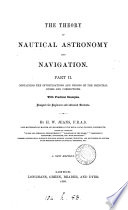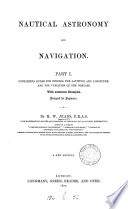 ... consequence of the whirling motion of the earth about its axis, the parts near the equator, which have the greatest velocity, acquire thereby a greater distance from the centre than the parts near the poles. ... consequence of the whirling motion of the earth about its axis, the parts near the equator, which have the greatest velocity, acquire thereby a greater distance from the centre than the parts near the poles.  Navigation and Nautical Astronomy - Page 54by H. W. Jeans - 1858Full view Navigation and Nautical Astronomy - Page 54by H. W. Jeans - 1858Full view - About this book
 | Joseph Guy - 1832 - 412 pages
...earth about its axis CHAPTER XXXVIII. THE PRECESSION OF THE EQUINOX. IT has been already observed, that the form of the earth is that of an oblate spheroid ; for by the earth's motion on its axis there is more matter accumulated all around the equatorial... | |
 | 1834 - 578 pages
...an oblate-spheroidal * form, bulging out at and about the equator, and flattened at tfie poles ; and that the equatorial diameter is longer than the axis or polar diameter. The excess of the equatorial above the polar diameter represents, when compared with the whole diameter,... | |
 | John Gummere - 1842 - 516 pages
...equator and parallels of latitude are circles, or nearly so. It therefore follows from the last article that the form of the earth is that of an oblate spheroid; that is, of a solid, such as would be generated by the revolution of a semi-ellipse pqp', about its... | |
 | Joseph Guy - 1845 - 370 pages
...earth about its axis CHAPTER XXXVIII. THE PRECESSION OF THE EQUINOX. IT has been already observed, that the form of the earth is that of an oblate spheroid ; for by the earth's motion on its axis there is more matter accumulated all around the equatorial... | |
 | Edward Duke - 1846 - 256 pages
...Hill militates against the supposition, that it was intended to represent the earth. It is thus said, that the form of the earth is that of an oblate spheroid, whilst this hill presents the form of a cone to the eye. The objection, when duly considered, carries... | |
 | H. W. Jeans - 1853 - 314 pages
...By actual measurement of a degree of latitude in different parts of the earth, it is found thatthe equatorial diameter is longer than the axis or polar...the axis and eq the equator. It is usual, however, E drawing the figure of the earth to exaggerate very much ellipticity ; this is done for the sake of... | |
 | John Gummere, Ezra Otis Kendall - 1854 - 484 pages
...equator and parallels of latitude are circles, or nearly so. It therefore follows from the last article that the form of the earth is that of an oblate spheroid; that is, of a solid, such as would be generated by the revolution of a semi-ellipse pqp', about its... | |
 | Elias Loomis - 1866 - 384 pages
...that the equator and parallels of latitude are very nearly, if not exactly, circles. Hence it appears that the form of the earth is that of an oblate spheroid; which is a solid generated by the revolution of a semi-ellipse about its minor axis. 44. Loss of weight... | |
 | Henry William Jeans - 1868 - 228 pages
...By actual measurement of a degree of latitude in different parts of the earth, it has been computed that the equatorial diameter is longer than the axis...the form of the earth is that of an oblate spheroid. It is usual, however, in drawing the figure of the earth to exaggerate very much its ellipticity ;... | |
 | Henry William Jeans - 1870 - 288 pages
...By actual measurement of a degree of latitude in different parts of the earth, it has been computed that the equatorial diameter is longer than the axis or polar diameter by 20 miles : the former being about 7924 miles ; the latter about 7898 miles, and that the form of the... | |
| |